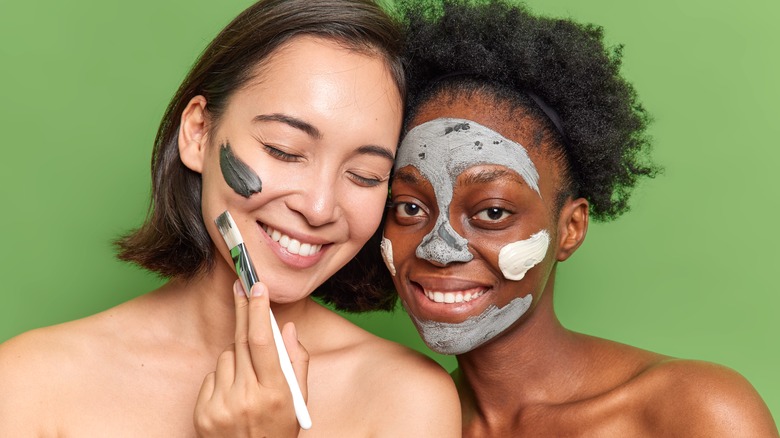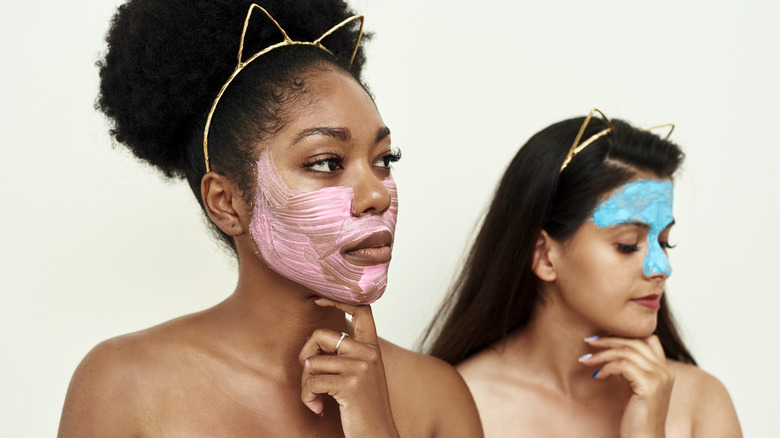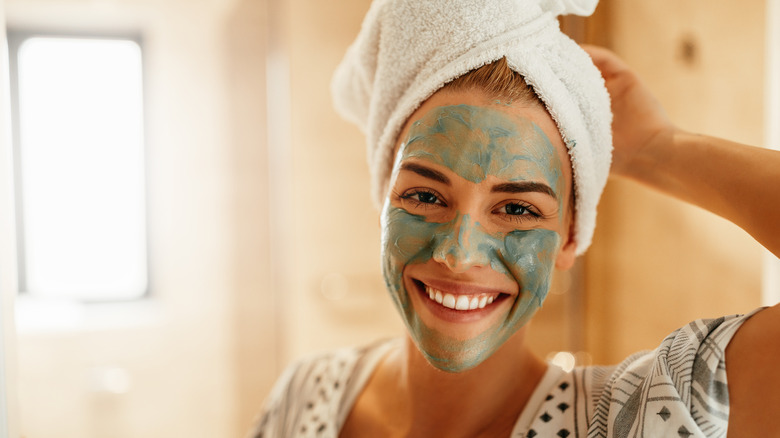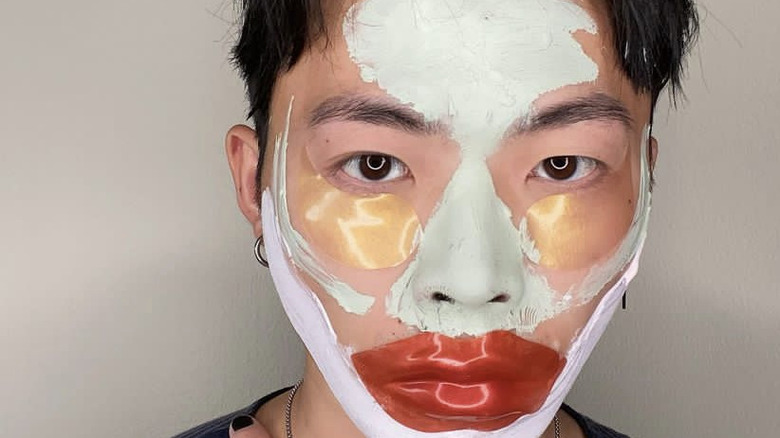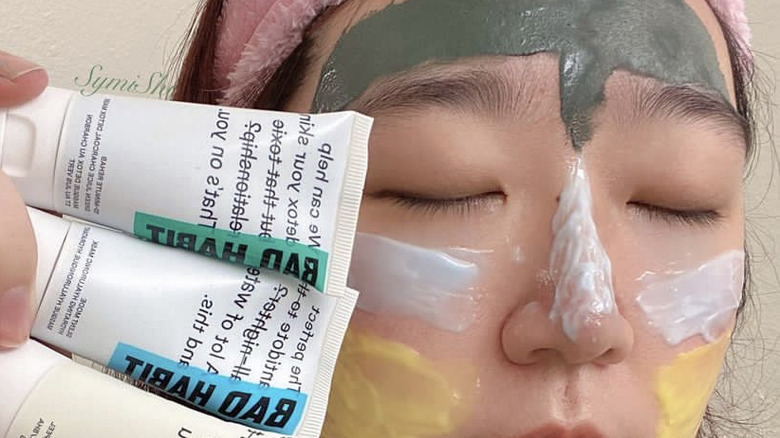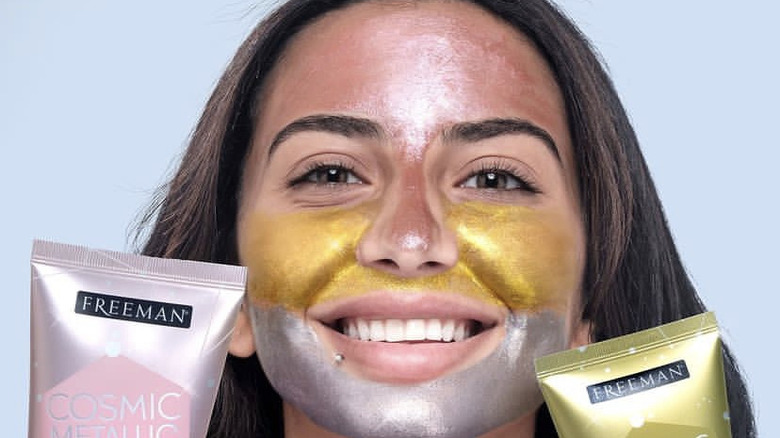Multimasking May Be Exactly What Your Skin Needs
We may receive a commission on purchases made from links.
Whether it's oiliness in your T-zone, hyperpigmentation on your forehead, or dryness around your cheeks, it is normal to have different skin concerns on specific areas of your face. And while we might sometimes want our skincare products to work with the same intensity on every part of our face, at other times your needs may be more focused and specific. With fine lines, large pores, hyperpigmentation, and acne on different zones of your face, chances are your one bottle of product will not be able to address all your skin concerns sufficiently. So it is with face masks, a beauty essential which, as Éminence Organic Skin Care describes, contain active ingredients and occlusives for better penetration into the skin. Face masks are usually designed to treat one skin concern at a time — detoxifying, hydrating, or exfoliating — and give the skin a much-needed boost. But if only one problem is the focus, what happens to the rest of your face? Well, a skincare technique called multimasking might help with that.
According to Skin City, multimasking is a skincare technique where you apply two or more face masks simultaneously but in different zones of your face or on top of each other sequentially. With multimasking, you can use different face masks targeting distinct skin concerns, adequately giving ALL parts of your skin the attention they need and creating a fantastic face cocktail of colors.
Benefits of multimasking
Besides the promise of treating the different zones of your face to the required actives, The Parlour Room adds that multimasking helps you make your own customized masks. Choosing and applying masks according to your skin's specific concerns in different areas makes a face mask unique to your skin and its needs. And it gets better. With multimasking, you're applying bits of different masks to different areas of your face and avoiding the areas your skin doesn't need the mask to be on. For Heyday Skincare, this means less waste, longer-lasting product(s), and even more effectiveness of the masks on the different face zones.
Multimasking also reduces the risk of overtreating. For instance, using an oil-absorbing mask on all parts of a face if you have combination skin can help control oil around the T-zone, but it can also lead to dehydration in the drier areas. However, with multimasking, there is no need to apply an oil-absorbing mask on all areas of the face; you only need to use it for the oily zones. And as BioClarity adds, applying multiple masks makes for an excellent at-home spa experience by and for yourself.
How to pick your masks
Now, before we get to the fun part, which is application, you have to identify your skin concerns on each part of your face. For example, you might have more fine lines than usual, or your pores could be large or congested. Whatever it is, note the concern and the zone it primarily affects.
According to Kiehl's, you can start by choosing two to four face masks, all with specific skin needs in mind. For example, for your T-zone, which is usually oilier and prone to congested pores, Milanesi Skincare says to choose a purifying mask with oil-absorbing ingredients like kaolin or charcoal. For cheeks, which are typically drier than the T-zone, pick a mask with moisturizing ingredients like vitamin E to hydrate that area. And for the eye region, which might be puffy or have fine lines, choose a mask with ingredients like hyaluronic acid to plump up the skin or caffeine to give a look of wakefulness (per Nivea).
How to multimask
Now that we've picked our masks, let's get to the fun part. First, applying masks only on clean skin is essential, so cleansing is an integral part of the process. As BioClarity says, cleanse your face with your favorite gentle cleanser or cleansing balm and rinse off thoroughly. After all, you only want to work on a clean base to get all the benefits from your mask cocktail. And now to the application.
According to Skincare, there are two techniques you can use while multimasking. First, of course, is zone multimasking, where you simultaneously apply different masks to different zones of your face. But there's also layer multimasking, a multimasking technique where you use your face masks one at a time, and you can choose this when your skin concerns are closely related yet almost contrasting. An example is skin that's both oily and dehydrated. Skincare explains that you can first layer your purifying mask to address your excess oil, rinse it off, and then apply a hydrating mask.
Multimasking for oily or combination skin, acne-prone skin, large pores, and dry skin
People with combination skin have a mix of skin types on different parts of their face: usually oily on the T-zone — which includes the forehead, nose, and chin — and drier everywhere else. For this, Paula's Choice suggests multimasking with a calming moisturizing mask on the drier parts of your face and a detoxifying or oil-absorbing mask like the TULA Detox In A Jar Exfoliating Treatment Mask on your T-zone. You can also use the oil-absorbing mask on areas of your face other than your T-zone and parts prone to breakouts (per Primally Pure).
For areas of the skin with enlarged pores, you can also multimask using a pore-refining mask on the area, usually one with kaolin or charcoal. And for drier regions on your face, try a hydrating gel or cream mask with humectants like the Glossier Moisturizing Moon Mask, which contains hyaluronic acid, squalane, and licorice root.
Multimasking for textured skin, hyperpigmentation, and fine lines
For zones of your face that have a rough texture, The Truth Beauty Company suggests multimasking with a gentle exfoliating and brightening treatment to encourage cell sloughing and regeneration for a smooth and radiant glow. An exfoliating and brightening treatment we love and recommend is the Blue Lagoon Iceland Weekly Renewal multimasking duo, which includes the Lava Scrub Mask for exfoliation and Mineral Mask for revitalizing the skin and providing hydration.
For zones of the face with darker patches due to hyperpigmentation or scarring, The Parlour Room says to consider using face masks containing vitamin C, a tone-improving antioxidant. And for signs of premature aging such as wrinkles and fine lines, Heyday Skincare suggests indulging those areas in some overnight peptide, probiotic, or lipid-rich treatments like the Éminence Organics Clear Skin Probiotic Masque to firm your skin while you sleep.
Who should multimask, and how often?
Many skincare trends can benefit all skin types and conditions with a few tweaks, and Healthline confirms that multitasking is one of them. The only thing that differs is what skin concerns the masks will be targeting and what areas you will be applying the masks on. For how often you should multimask, L'Oréal Paris suggests trying it about two to three times a week — but if that frequency is not doable for your routine, you can save it for special occasions or self-care Sundays.
While multimasking, it's essential to keep the mask on for the time specified on the product and no longer. And when you're done with your masks and have rinsed them off, Kiehl's says to finish by completing the rest of your skincare routine. Your skin is most invigorated and decongested after a good mask session, so be sure to hydrate and protect it with some moisturizer and sunscreen if you're indulging in the daytime.
